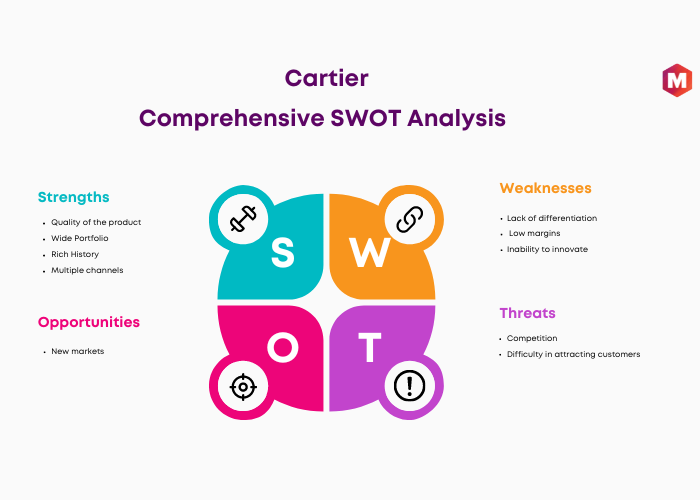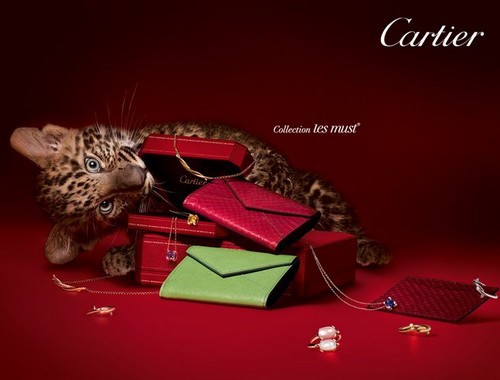Let’s explore the SWOT analysis of Cartier by understanding its strengths, weaknesses, opportunities, and threats.
One of the biggest names in the jewelry and luxury products business, Cartier Monde is also the world’s biggest manufacturer of designer custom-made luxury jewelry. With around 200 retail stores across almost 125 cities, including Paris, New York, and London, as well as various parts of the US, the company has lately also been moving into smaller cities.
The focal point of Vendome Luxury Group PLC—Cartier—is a subsidiary of Swiss-based, South African company CompagnieFinancière de Richem t AG. Cartier is responsible for almost 72 % of the Vendome group’s annual sales market share. In addition to Cartier, Vendome sells other luxury brands like Alfred Dunhill, Vacheron & Constantin, Lancel, Mont Blanc, Piaget, and Chloe.
Cartier is also famous for its custom-made jewelry and other merchandise, and it has many celebrity customers. However, the company continues to have limited growth in its retail space. Despite the growth spurt in mall culture, its presence is lower than that of most competitors. Cartier registered an annual turnover of 6.1 billion USD in 2016.
Overview of Cartier:
- Industry: Retail
- Founded: 1847, 177 years ago
- Founder: Louis-François Cartier
- Headquarters: Paris, France
- Area served: Worldwide
- Key people: Cyrille Vigneron (CEO)
- Products: jewelry, watches
- Revenue: $6.2 billion (2020)
- Parent: Richemont
- Website: www.cartier.com
Table of Contents
SWOT analysis of Cartier
Strengths of Cartier
1. Quality of the product
Cartier’s products are innovative and luxurious, designed for individual customers. The designs are unique and ensure that individual tastes are met. The detailing of the products is also delicate, and even minute details are taken care of, a quality it has built primarily because of its background in watchmaking.
2. Wide Portfolio
Though Cartier is popular as a maker of watches and jewelry, the company also makes cigarette lighters, scarves, and other relatively low-key accessories in the economy class. The wide portfolio, which also includes low-priced items, ensures that the customer base is vast.
3. Rich History
Cartier was first established in 1819 when the French designer Louis François Cartier made watches and jewelry. He first started training under Picard. Since then, the designer has been creating signature custom-made jewelry pieces and currently has operations worldwide.
4. Multiple channels
Cartier sells through several distribution channels and reaches out to an extensive network of customers. The company has around 200 retail outlets and exclusive Cartier stores, most of which are in Tier-1 cities or metros. It also sells through third-party retailers and has an online e-retailer partner and a website.
5. Positioning
Cartier has always been positioned as something that epitomizes both luxury and elegance. The designs are inspired by history and have a medieval or old-time feel. Though it was initially a luxury brand, in order to expand, the brand has now repositioned itself as a lifestyle brand.
Weaknesses of Cartier
1. Lack of life initiation
Cartier continues to rely completely on its brand image, which has been created over the years. As competition has grown, more and more medium-sized businesses are making products that are similar to them in design,, making it difficult for Cartier to create a strong difference.
2. Low margins
Cartier is a luxury brand and can thus cater to only the higher-income segment. The costs of designing and marketing, retailing and distribution, etc., are excessive for luxury brands. The low margins and reduced sales volumes have resulted in huge losses for the business.
3. Inability to innate
Competition in the luxury category is increasing. When it began its operations, Cartier was a pioneer in the designer and luxury category and thus had a vast customer base. However, there is a lot of competition today, and contemporary designers are getting the upper hand in the market.
Opportunities of Cartier
1. New markets
There are new markets and new categories in luxury goods. Some of the categories involve designer formal wear, cuff links, shoes, etc., which are new avenues opening up.
Threats of Cartier
1. Competition
Cartier’s competitors are Pierre Cardin, Versace, and Graff Diamonds.
2. Difficulty in attracting customers
Luxury brands face a massive challenge from customers switching Rands. Since their purchase frequency is low, the company needs to retain customers as much as possible.
Conclusion
To summarize, Cartier’s strengths include its unequaled product quality, long tradition, and extensive product selection, which appeal to a wide range of customers. However, the brand faces several obstacles, including severe competition, the need to identify itself in a crowded market, and pressure from low margins in the premium segment.
Despite these challenges, Cartier has chances to expand into new markets and product categories, leveraging its heritage of artistry and luxury positioning. To succeed in the changing luxury marketplace, Cartier must continue to innovate while adhering to its legacy of elegance and exclusivity, ensuring it remains a top choice for discerning consumers worldwide.
Liked this post? Check out the complete series on SWOT


